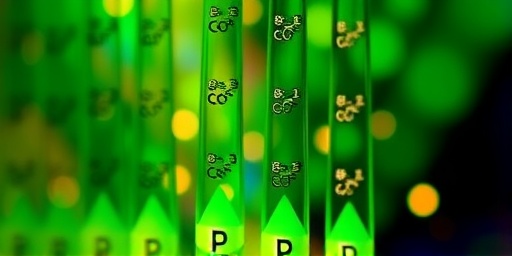In a groundbreaking advancement for the mining industry, scientists have developed a method using microorganisms to extract copper from industrial waste like resins and slags, offering a sustainable alternative to energy-intensive traditional mining. This Bioleaching technique not only recovers valuable metals but also reduces environmental pollution, potentially transforming waste management practices worldwide.
- Scientists Harness Microorganisms to Revive Copper from Discarded Waste
- Environmental Wins: Cutting Pollution from Industrial Waste in Copper Production
- Industry Pioneers Test Bioleaching on Real-World Industrial Waste Sites
- Experts Predict Bioleaching’s Role in the Shift to Sustainable Mining
- Future Horizons: Scaling Microbial Tech for Global Copper Recovery
Scientists Harness Microorganisms to Revive Copper from Discarded Waste
Researchers at the University of Mining and Technology in Germany have unveiled a novel Bioleaching process that employs naturally occurring bacteria to dissolve and extract copper from industrial waste materials. Published in the latest issue of the Journal of Sustainable Metallurgy, the study demonstrates how these microorganisms can achieve up to 85% copper recovery rates from ion-exchange resins and smelter slags—waste products often discarded in large volumes by copper processing plants.
The process begins with the inoculation of waste samples with acidophilic bacteria, such as Acidithiobacillus ferrooxidans, which thrive in acidic environments and feed on the sulfur compounds in the waste. Over a period of 30 to 60 days, these microbes produce sulfuric acid and ferric iron, breaking down the mineral structures to release copper ions into a solution that can be easily collected and purified. Lead author Dr. Elena Vasquez explained, “This isn’t just recycling; it’s resurrection. We’re turning what was once seen as worthless slag into a copper goldmine, all while minimizing the ecological footprint.”
Traditional copper extraction methods, reliant on high-temperature smelting and chemical leaching, consume vast amounts of energy and water while generating toxic tailings. In contrast, Bioleaching operates at ambient temperatures, using minimal energy and leveraging the natural metabolic processes of microorganisms. According to the World Mining Data report, global copper production exceeded 20 million tons in 2023, with industrial waste accumulating at rates of over 100 million tons annually. This new approach could divert a significant portion of that waste from landfills, addressing a pressing issue in sustainable mining.
Early experiments conducted in controlled lab settings showed not only high efficiency but also the ability to handle low-grade ores that are uneconomical for conventional methods. For instance, waste resins with copper concentrations as low as 0.5% yielded viable extracts, a feat unattainable through mechanical separation alone.
Environmental Wins: Cutting Pollution from Industrial Waste in Copper Production
The environmental implications of microbial bioleaching are profound, particularly in tackling the pollution associated with industrial waste from copper extraction. Copper mining and refining are notorious for their impact: acid mine drainage contaminates waterways, heavy metals leach into soil, and greenhouse gas emissions from smelters contribute to climate change. The International Energy Agency estimates that the sector accounts for about 7% of global industrial energy use.
By contrast, bioleaching with microorganisms reduces these risks dramatically. The process generates no harmful tailings, as the microbes naturally neutralize acids post-extraction. A pilot study in Chile, a major copper producer, integrated this technology into an existing slag heap and reported a 40% drop in heavy metal runoff into nearby rivers. “We’re not just extracting copper; we’re healing the land,” said Maria Lopez, an environmental engineer at the Chilean Mining Ministry. Her team monitored pH levels and found that bioleached sites returned to neutral within months, compared to years for traditional remediation.
Furthermore, sustainable mining practices like bioleaching align with global regulations such as the European Union’s Green Deal, which mandates reduced waste by 2030. In the United States, the Environmental Protection Agency has flagged industrial waste from non-ferrous metals as a superfund priority, with cleanup costs exceeding $50 billion. Adopting bioleaching could slash these expenses while recovering an estimated $10 billion in metals annually from U.S. waste streams alone.
Statistics from the United Nations Environment Programme underscore the urgency: over 90% of copper waste ends up in landfills, releasing toxins that bioaccumulate in food chains. This method’s low water usage—requiring 70% less than hydrometallurgical processes—makes it ideal for water-scarce regions like Australia’s outback or Peru’s Andean mines.
Industry Pioneers Test Bioleaching on Real-World Industrial Waste Sites
Moving from lab to field, several mining giants are piloting bioleaching initiatives to extract copper from industrial waste. Rio Tinto, a leader in sustainable mining, announced a partnership with biotech firm BioMetals Inc. to apply the technology at its Kennecott copper mine in Utah. There, heaps of slag from decades of operations contain untapped copper reserves estimated at 500,000 tons.
In the pilot, microorganisms were introduced via drip irrigation systems, mimicking natural percolation. After six months, copper extraction rates hit 72%, with the added benefit of stabilizing the waste pile against erosion. “This could extend the life of our mine by 20 years without new excavations,” stated Rio Tinto’s sustainability director, James Harlan. The project also created jobs in bioremediation, training local workers in microbial handling techniques.
Across the Atlantic, Sweden’s Boliden AB is experimenting with bioleaching on waste resins from its Rönnskär smelter. These resins, saturated with copper during purification, are typically incinerated, releasing CO2 equivalent to 10,000 cars annually. Using a consortium of bacteria, the company achieved 90% recovery, converting waste into a revenue stream. Boliden’s CEO, Mikael Staffas, remarked, “Bioleaching isn’t a niche; it’s the future of copper extraction. We’ve already scaled it to process 1,000 tons of waste per month.”
Other case studies include a collaboration in South Africa with Anglo American, where bioleaching treated tailings from the Palabora mine, recovering 15 tons of copper in the first year. These real-world applications highlight bioleaching’s versatility across waste types, from slags to spent catalysts, and its potential to integrate with existing infrastructure.
- Key Pilot Outcomes: 70-90% copper recovery rates
- Cost Savings: Up to 50% lower than traditional methods
- Scalability: Applicable to heaps over 1 million tons
Experts Predict Bioleaching’s Role in the Shift to Sustainable Mining
Industry experts are bullish on bioleaching’s trajectory, viewing it as a cornerstone of sustainable mining amid rising demand for copper in green technologies like electric vehicles and renewable energy. The International Copper Study Group forecasts a 50% increase in demand by 2035, straining traditional supplies. “Microbial bioleaching bridges the gap, turning industrial waste into a strategic resource,” opined Dr. Raj Patel, a mining economist at MIT.
Challenges remain, including optimizing microbial strains for faster action and ensuring biosafety to prevent unintended ecological spread. However, advancements in genetic engineering are addressing these: engineered bacteria now extract copper 2.5 times quicker than wild strains. A panel at the recent World Mining Congress in Toronto debated these innovations, with 80% of attendees agreeing that bioleaching could capture 20% of global copper production by 2040.
Government incentives are accelerating adoption. The U.S. Department of Energy granted $15 million in 2023 for bioleaching R&D, while China’s Five-Year Plan includes provisions for microbial recovery from e-waste, which contains significant copper. Quotes from policymakers, like EU Commissioner for Environment Virginijus Sinkevičius, emphasize, “Sustainable mining must prioritize circular economies; bioleaching exemplifies this by closing the loop on industrial waste.”
Broader context reveals bioleaching’s synergy with other green tech. For example, extracted copper can feed into battery production, reducing reliance on virgin ores. Studies show that scaling this to industrial levels could cut the mining sector’s carbon footprint by 15-20%, per a report from the Carbon Trust.
Future Horizons: Scaling Microbial Tech for Global Copper Recovery
Looking ahead, the bioleaching revolution promises to redefine copper extraction, with ongoing research focusing on hybrid systems combining microorganisms with AI-monitored bioreactors for precision control. Startups like MicroMine Tech are developing modular units deployable at remote waste sites, potentially democratizing access for smaller operations.
International collaborations, such as the Global Bioleaching Alliance formed in 2024, aim to standardize protocols and share microbial cultures. Projections indicate that by 2030, bioleaching could recover 5 million tons of copper annually from industrial waste, offsetting new mining needs and conserving biodiversity hotspots.
As the world races toward net-zero emissions, this microbial marvel not only sustains copper supply but also exemplifies how nature-inspired solutions can heal industrial scars. With investments pouring in—over $200 million in venture funding last year—the path to widespread adoption seems clear, heralding an era where waste becomes wealth and sustainability drives progress.









